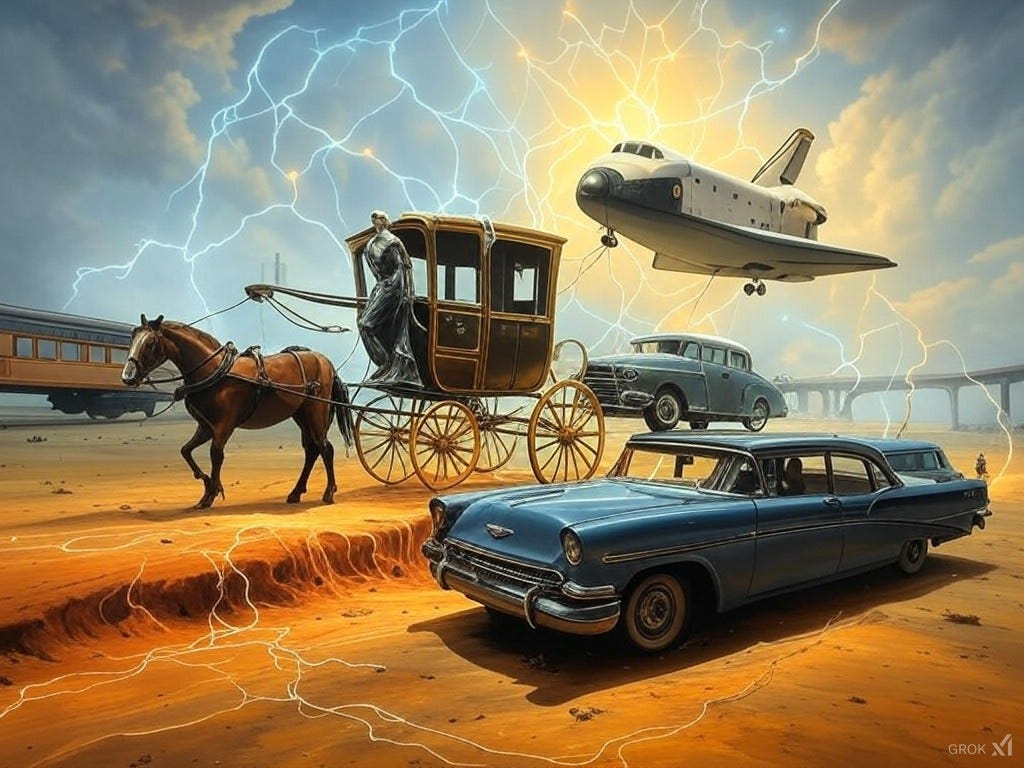The Journey of the Hidden State in LLMs: From Horse-Drawn Carriages to Space Shuttles
Explaining how the hidden state is a set of vectors that evolve over time to bring meaning to text.
Imagine if the complexity of understanding language by Large Language Models (LLMs) like Grok could be likened to the evolution of transportation from the 19th century to the modern era. In this analogy, the hidden state of an LLM is akin to our vehicles, evolving from simple horse-drawn carriages to the sophisticated Space Shuttle, all while adhering to a consistent "width" - in this case, the dimensionality of vectors.
The Hidden State: A Vector Journey
In LLMs, the hidden state represents the model's internal understanding of the text it processes. It's a collection of vectors, each corresponding to a word or token in the input, and this collection evolves through various computational layers, gaining more "meaning" or "intelligence" with each step.
1. The Embedding Layer: Horse-Drawn Carriages
Starting Point: Just as horse-drawn carriages were the basic form of transport, providing mobility but not much beyond that, the embedding layer translates raw text into vectors. Each word, like "power" or "rocket," gets mapped to a vector in a high-dimensional space (e.g., 768 dimensions). Here, the hidden state is simple; it captures the essence of words but lacks deep context or understanding.
Dimensionality: These vectors are consistent in size, much like how roads were built to accommodate carriages of a certain width.
2. The Attention Layer: The Advent of Cars
Adding Context: Cars brought speed, efficiency, and the ability to navigate complex road networks better than carriages. Similarly, the attention layer in LLMs computes the relationships between words, transforming the hidden state into context-aware vectors. Now, each word's meaning is enriched by understanding its role in the entire sentence. For the query, "How much power does a Space X rocket have in horsepower?", attention helps in understanding that "power" relates to "rocket" and "horsepower" in a specific, technical context.
Maintaining Dimensions: Despite this leap in sophistication, the vectors remain of the same dimension, just as cars adhere to the road widths originally set for carriages.
3. The Feed-Forward Network (FFN): The Space Shuttle Era
Peak of Intelligence: The Space Shuttle represents the pinnacle of human ingenuity in transportation, capable of leaving the Earth's atmosphere. In parallel, the Feed-Forward Network takes the context-aware vectors and applies non-linear transformations, infusing them with learned knowledge from billions of parameters. This step creates FFN-enhanced vectors, where the hidden state now encapsulates not just text and context but also an abstraction of world knowledge, like understanding the conversion of rocket thrust to horsepower.
Still the Same Size: Remarkably, these vectors maintain their dimensionality. Just as the shuttle had to fit through tunnels or under bridges built for far simpler vehicles, the hidden state vectors must work within the same size constraints from earlier layers.
The Evolution of Meaning
Throughout this journey, the hidden state vectors, while always of the same dimension, increase in complexity and capability:
From Basic to Advanced: The hidden state starts with basic semantic understanding, grows to comprehend context, and finally integrates deep knowledge, akin to the progression from horse-drawn carriages through cars to space shuttles.
Constraints and Evolution: The analogy highlights how, despite evolving functionality, there are foundational constraints (like vector size or road width) that guide this development.
Conclusion: The Road Ahead
Much like how transportation has evolved while still fitting within historical standards, the hidden state in LLMs like Grok advances in intelligence and utility, transforming raw text into meaningful insights. When asked "How much power does a Space X rocket have in horsepower?", the model navigates through these layers, not changing the fundamental "width" of the vectors but significantly enhancing what they can represent. As we continue to innovate in both AI and transportation, we see how progress respects the past's foundations while pushing the boundaries of what's possible.



